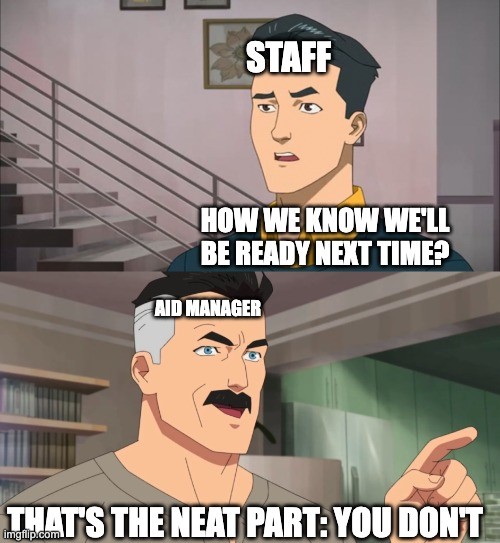| Author: | Giulio Coppi |
| Date: | 21. December 2023 |
The management of digital humanitarian transformation and other fairytales
Tons of ink have been invested to explain the challenges faced by not clearly defined aid actors in their digital transformation journey, and even more on why humanitarians struggle to harness digital to improve their work.
Who shall we assess and evaluate for the state of humanitarian digital transformation? Just like for most things in a capital-driven age, to find out you have to ask the right questions and follow the money: Who in the organisation controls the budget? Who leads the recruitment of new staff the design of their job description and requirements? Who sets the priorities and tasks for their team?
The answer is: Managers. Recent research has found that “nonprofit leaders lag others in their organisations in all dimensions of digital transformation by 26 percent. And for digital implementation, the gap is even greater—35 percent.” Translated from the purified language of self-absolving humanitarian reporting, vulnerable populations depend on strategic decisions made by mostly digitally ignorant or digital illiterate managers.
Once you get to crack this hat trick, most of the ‘complexity’ that is allegedly holding the sector back vanishes. Field teams are not digitally savvy because hiring managers did not consider it important to budget accordingly, identify the right profile, or did not know how to evaluate digital skills when they built their team. Digital infrastructure teams and assets are not adequate to the ambition promised to the board and external stakeholders because managers do not see the need for what they consider fancy skillsets or pricey gadgets, and thus fail to build arguments that would support such investments and decision-making. This is such an open secret, that the sector had to create a dedicated training to try and address this gap.
In the end, the argument goes, if a humanitarian can do a bit of everything (author’s note: they cannot and should not), why can’t a ‘humanitarian programmer’ help teams and multitask with all things digital across the spectrum? Why isn’t it possible to hire a motivated (read: underpaid) software engineer to do problem scoping, wireframing and design thinking, backend and frontend development, and even some cybersecurity, maybe while also running the IT desk? How different might these things be, why would a programmer not be able to do it all? Why do we have to pay for so many people and different skillsets, and so many pieces of software?
Roaring Land Cruisers and the Purity of Aid
Let’s start from my hottest take: If it can’t be digitised and run remotely, very likely a local actor can lead any aid activity (and probably much better than an international actor). Increasingly, country offices of big INGOs are led and staffed with regional experts, in a warped implementation of what they believe localisation means. This begs the question of why their organisation would be needed at all in the first place. Wouldn’t a local NGO with the same staff (and grants) achieve the same results? Couldn’t the same local management get the few truly irreplaceable positions hired using international consultancy contracts?

Most of the “added value” claimed by INGOs is residual, non-first mile related, and largely represented by scale-sensitive functions, such as logistical support, surge capacity, advocacy\comms, grant management and M&E capabilities. All these functions could be provided through a platform model (hybrid, both physical and digital) which allows sharing responsibilities without the need for a hierarchical dominance by an international actor.
The real edge would be the possibility to leverage equitable partnerships and analytics at scale based on the principle of subsidiarity, to provide data, tech and strategic support that would hardly be accessible or possible at the local level and in the midst of a crisis response. Unfortunately, these are all concepts that make management freeze. Sometimes, it might trigger a severe flight-or-fight response, so if you ever introduce this idea in a management meeting, make sure to 1) stay close to an emergency exit, and 2) make sure there are no windows wide open for decision-makers to escape (metaphorically or physically).
Instead, what do managers usually do? They dogmatically cling to the direct delivery — or worse, the atrocious stay and deliver — line of business, despite all evidence that the whole concept of “humanitarian space” is flawed to begin with. As the strategy period runs by, their digital transformation commitment, underfunded and neglected, withers and degrades, resulting in a mere set of scattered data-inspired projects. In a way, it’s a generational issue, just as much as it is a cultural one: no matter how hard they try to believe to be modern and updated, many humanitarian managers were forged in the lies of the quick-and-dirty era and are more at ease navigating a system designed by 20th century standards. Many still see tech and digital as something other than real humanitarian work, neglecting a trend that is inevitable.
If there’s one thing many humanitarian managers fear more than an audit from their donors, is the idea of watering down the ethos and altruistic myth of humanitarian work. In other words: roaring Land Cruisers, impassable mud roads, forgotten ‘beneficiaries’ in need and waiting for the help of a humanitarian organisation. The purest idea of humanitarian aid cannot stand being contaminated by geeky stuff. The White Savior shall prevail, in ‘the field’ and in person. This leaves tech-positive folks often stuck in between openly hostile managers and the turbotech ones, those riding the hype with little to no regard for the ethics of it.
Tech as a Measurable Factor for Outcomes
The other — more practical — reason why many humanitarian managers are not always readily embracing digital and data, can be reasonably summarised in two essential points:
- They would need to learn how to work\read\analyse and use data outputs for decision-making, or start hiring data experts who can do that at the pro level. But most of all, they would need to find the time to read and understand all that data, insights, and — the horror — the analysis.
- It significantly reduces their leeway and discretion. ‘True humanitarians’ are used to being always available when receiving an urgent call, then fill in a field trip request form, identify any available Land Cruiser, and assemble the team that will follow them on the path of glory and solidarity. Data and tech might break that profane ritual and put managers in the uncomfortable position to take unpopular decisions or draw uneasy conclusions when confronted with evidence.
As they twitch and twist in and out of shape trying to justify why humanitarian expats are still needed and what is that they do that is so unique about them, managers often find some solace in the idea that the work of their organisation is appreciated for its quality. Mind me, quality that is appreciated by donors and partners, not necessarily by the communities. In some cases, it might not be a lie: we just do not know if those quality claims are true, and that’s absurd.
Communities’ opinion about the humanitarian services received is not properly recorded by standard M&E protocols or feedback mechanisms, thus leaving the sound sleep of the good-willed humanitarian manager intact. Also, very few communication channels exist for communities to record or publish their opinions, views and concerns not just in terms of need, but also in terms of satisfaction with the help received.
But alas, that pesky data could ruin all of this for the Aid Cowboy. It’s one thing to run the numbers and figures over and over again until they (kind of) magically make sense. But an open data policy where your laundry is done in the open, including all the tweaks and changes, and where communities can publicly talk about you and your services, that would be a different environment to deal with. An environment that could amplify change and transformation.
The system has the knowledge, the data and the tools to do better already. Just to name a few tools, scenario-based modelling and predictive analytics are a viable way to present managers with all the options available to them, leaving the responsibility of the final decision on when and how to prepare for each possible scenario to the local team.
But these are not a silver bullet, and this is also where technology stops. Because accountability starts at home and offline. In theory, most INGOs already demand their local leadership analysis, planning and forecasting exercises as part of their contingency planning; in practice, hardly any country management team goes beyond a skimpy narrative document explaining what they will do if unspecified bad things happen. In one of my last roles, in an all-hands call discussing yet another internal report detailing a failed response, I asked if we were then going to audit all field offices to check they had contingency plans and crisis scenarios in order. The response from senior management was clear: That was not a battle they were interested in picking. Unfortunately for them (and for the affected communities), being honest doesn’t make you right. It does tell you what the organisational priorities are though.

In conclusion
No data system or digital tool can impose the views and desires of communities over the expected standards and deliverables imposed by donors and decision-makers. No tech can force aid actors to adjust their strategic decision-making and operational planning process to incorporate communities’ voices and decisions in their learning and policies. No app can bring intersectionality and queer needs in the priority list of the priorities to be covered as part of a humanitarian response. No digital tool can force a manager to be removed or replaced if contingency plans and scenarios are not designed, adhered to, and kept in good order. No predictive analytics system can make a global operations team assume their responsibilities and stand down after a series of botched responses.
Behind each technology there is – or should be – a human being that calls the shots, and a manager that takes decisions, is accountable and responsible. This is the very core of the humanitarian mandate that INGOs claim to be necessary for.
Being a humanitarian manager cannot be a 100% fail-safe job. A manager is supposed to handle strategy, which includes mastering the most appropriate systems and approaches across your programmes so that what is unpredictable to an outsider is a possibility for your team. Falling short from managing and responsibly nurturing innovations to make this happen, is to me a clear sign of professional failure. And in case of failure, as they say, the buck has to stop somewhere. But in the humanitarian field the buck keeps roaming free from an INGO to the next one, powered mostly by good intentions and impunity.
When fundraising or advocating for access, humanitarians claim to be serving people’s rights, but rights MUST be protectable and enforceable by a court or an authority of sorts.
If you cannot exercise a right, you do not really have one. As proposed since 2017, a first step would be to set up an independent ombudsman for investigating alleged critical online and offline incidents, and for making sure that requests for edit, or removal of personal data are complied with by all connected data protection officers in the network. Different solutions might also help improving the situation but whatever the options, inaction is not one of them. We need Aid Cowboys to care about digital rights, just as much as they care about their Land Cruiser.
Giulio Coppi is Senior Humanitarian Officer at Access Now and a IARAN Fellow focusing on Humanitarian Future and Foresight. He publishes on emerging technologies and humanitarianism.
(Images are by the author through IMGflip.)



Related posts
Data & Digitalisation
The digital capacity of German humanitarian action
18.12.2023The use of technology to strengthen accountability in humanitarian action – a (not) so perfect match?!
11.04.2023